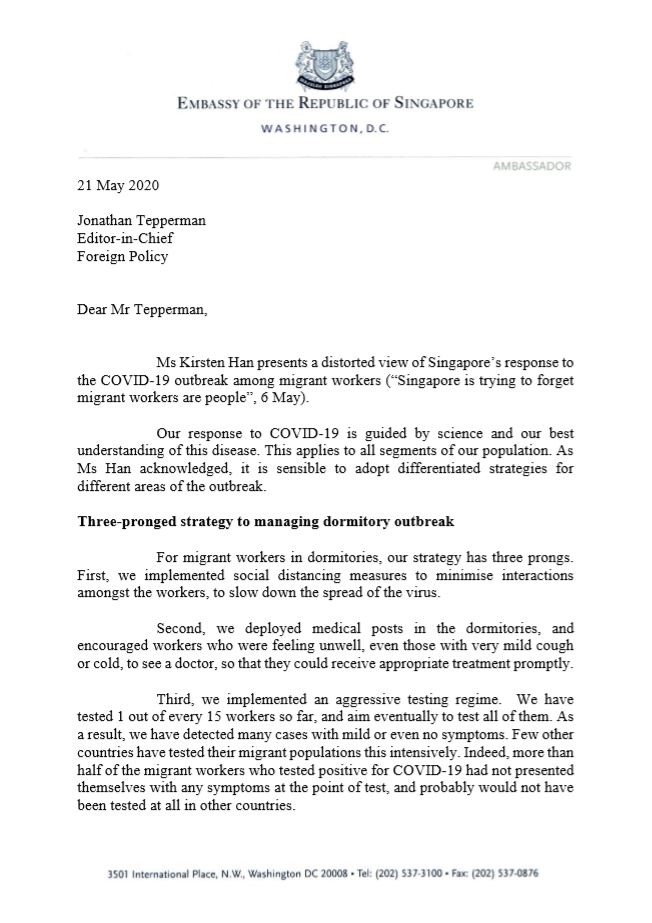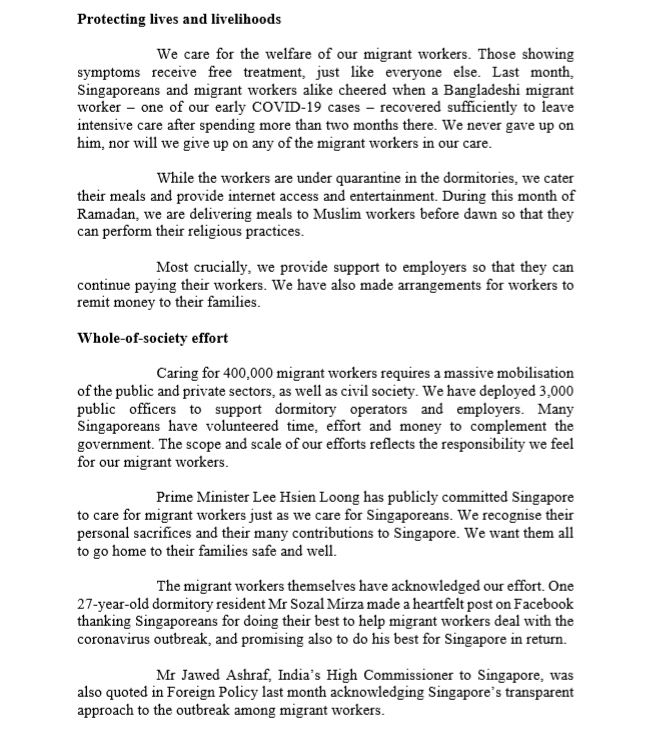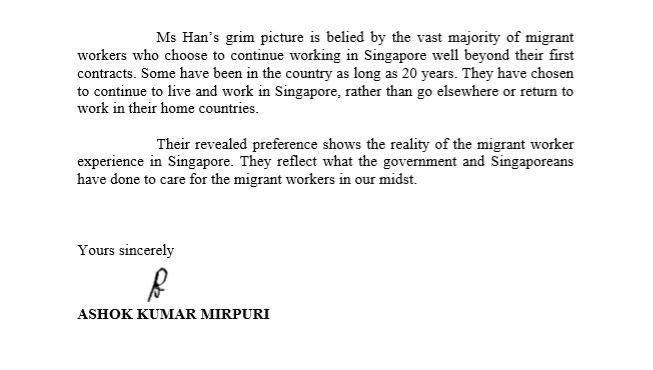Letter to the Editor - Foreign Policy
27 May 2020
Singapore Ambassador to the United States, Ashok Kumar Mirpuri, wrote to Foreign Policy in response to the article “Singapore is trying to forget migrant workers are people” published on 6 May 2020.
Singapore Ambassador to the United States, Ashok Kumar Mirpuri, wrote to Foreign Policy in response to the article “Singapore is trying to forget migrant workers are people” published on 6 May 2020. Foreign Policy refused to publish Ambassador Mirpuri’s letter to the editor despite previously carrying letters to the editor from Ambassadors accredited to the United States and spokespersons from various Ministries of Foreign Affairs in 2019.
The full text of Ambassador Mirpuri’s letter is below.
21 May 2020
Jonathan Tepperman
Editor-in-Chief
Foreign Policy
Dear Mr Tepperman,
Ms Kirsten Han presents a distorted view of Singapore’s response to the COVID-19 outbreak among migrant workers (“Singapore is trying to forget migrant workers are people”, 6 May).
Our response to COVID-19 is guided by science and our best understanding of this disease. This applies to all segments of our population. As Ms Han acknowledged, it is sensible to adopt differentiated strategies for different areas of the outbreak.
Three-pronged strategy to managing dormitory outbreak
For migrant workers in dormitories, our strategy has three prongs. First, we implemented social distancing measures to minimise interactions amongst the workers, to slow down the spread of the virus.
Second, we deployed medical posts in the dormitories, and encouraged workers who were feeling unwell, even those with very mild cough or cold, to see a doctor, so that they could receive appropriate treatment promptly.
Third, we implemented an aggressive testing regime. We have tested 1 out of every 15 workers so far, and aim eventually to test all of them. As a result, we have detected many cases with mild or even no symptoms. Few other countries have tested their migrant populations this intensively. Indeed, more than half of the migrant workers who tested positive for COVID-19 had not presented themselves with any symptoms at the point of test, and probably would not have been tested at all in other countries.
Protecting lives and livelihoods
We care for the welfare of our migrant workers. Those showing symptoms receive free treatment, just like everyone else. Last month, Singaporeans and migrant workers alike cheered when a Bangladeshi migrant worker – one of our early COVID-19 cases – recovered sufficiently to leave intensive care after spending more than two months there. We never gave up on him, nor will we give up on any of the migrant workers in our care.
While the workers are under quarantine in the dormitories, we cater their meals and provide internet access and entertainment. During this month of Ramadan, we are delivering meals to Muslim workers before dawn so that they can perform their religious practices.
Most crucially, we provide support to employers so that they can continue paying their workers. We have also made arrangements for workers to remit money to their families.
Whole-of-society effort
Caring for 400,000 migrant workers requires a massive mobilisation of the public and private sectors, as well as civil society. We have deployed 3,000 public officers to support dormitory operators and employers. Many Singaporeans have volunteered time, effort and money to complement the government. The scope and scale of our efforts reflects the responsibility we feel for our migrant workers.
Prime Minister Lee Hsien Loong has publicly committed Singapore to care for migrant workers just as we care for Singaporeans. We recognise their personal sacrifices and their many contributions to Singapore. We want them all to go home to their families safe and well.
The migrant workers themselves have acknowledged our effort. One 27-year-old dormitory resident Mr Sozal Mirza made a heartfelt post on Facebook thanking Singaporeans for doing their best to help migrant workers deal with the coronavirus outbreak, and promising also to do his best for Singapore in return.
Mr Jawed Ashraf, India’s High Commissioner to Singapore, was also quoted in Foreign Policy last month acknowledging Singapore’s transparent approach to the outbreak among migrant workers.
Housing migrant workers
Any approach to the welfare of migrant workers must take into account practical realities. Singapore is an ageing society with a small indigenous workforce. The city-state has no hinterland from which to draw additional workers. We will therefore always need migrant workers.
Housing migrant workers in land scarce Singapore can never be a straightforward matter. As the numbers grew, so too did the challenge. The best option was to house workers in dormitories, built to specified standards.
We have progressively raised the required standards of worker dormitories. In 2015, the Government passed legislation to require larger dormitories to provide recreational and health facilities, alongside amenities like grocery shops.
Dormitories provide communal living, allowing workers to socialize and relax together, cook and eat together, and pray together. Workers far away from home need social and emotional support, and the design of dormitories took this into consideration.
All communal living spaces, whether dormitories, nursing homes, cruise ships or aircraft carriers, are at risk in an infectious disease outbreak. Recognising these risks, in January we instructed dormitory operators to limit communal interactions, step up cleaning, require temperature checks, distribute hand sanitizers and to close recreation centres and gyms in the dormitories, among other measures. These measures were more stringent than those required of the general population.
Up to the middle of March, there was only one known cluster of infection among migrant workers, only two of whom lived in dormitories. When cases grew sharply despite the precautionary measures, we mobilised a massive effort to secure the health and well-being of our migrant workers.
Just as we have controlled the spread of COVID-19 in the rest of Singapore through stringent circuit breaker measures, with time and discipline we are bringing the situation in the dormitories under control.
Going forward
Our response has not been perfect, and there certainly are areas we can improve. We are determined to learn from this episode and will do a thorough review after the crisis is over.
Ms Han’s grim picture is belied by the vast majority of migrant workers who choose to continue working in Singapore well beyond their first contracts. Some have been in the country as long as 20 years. They have chosen to continue to live and work in Singapore, rather than go elsewhere or return to work in their home countries.
Their revealed preference shows the reality of the migrant worker experience in Singapore. They reflect what the government and Singaporeans have done to care for the migrant workers in our midst.
Yours sincerely,
ASHOK KUMAR MIRPURI




